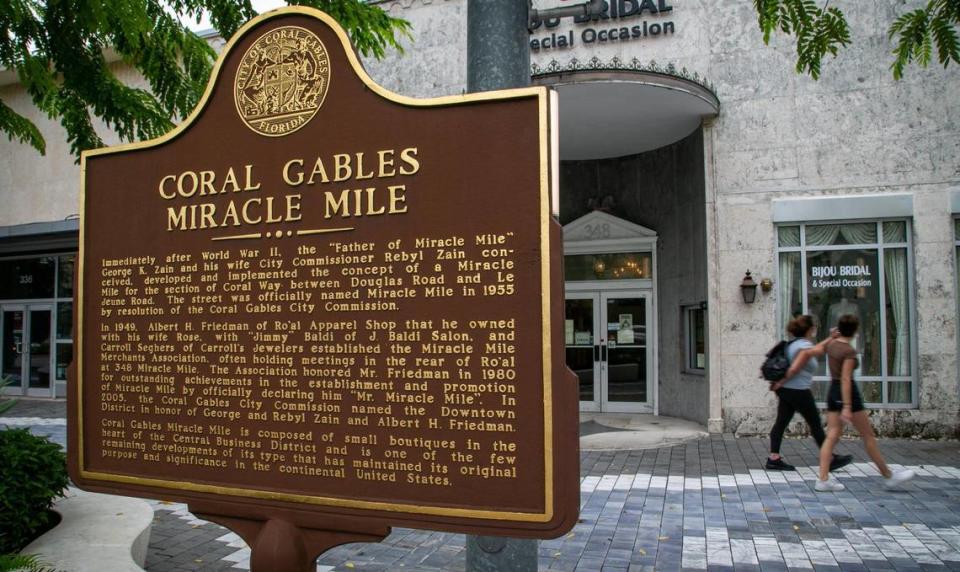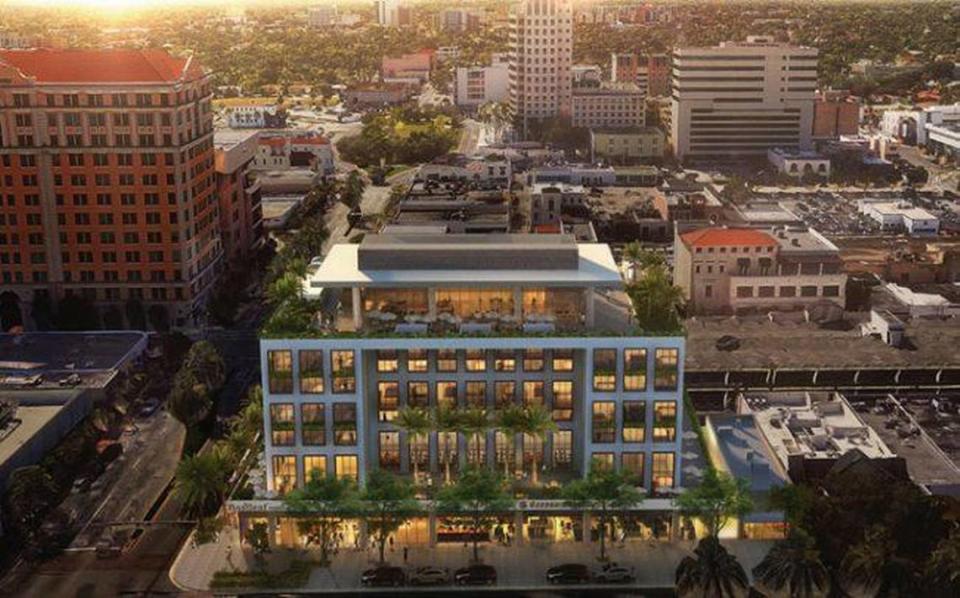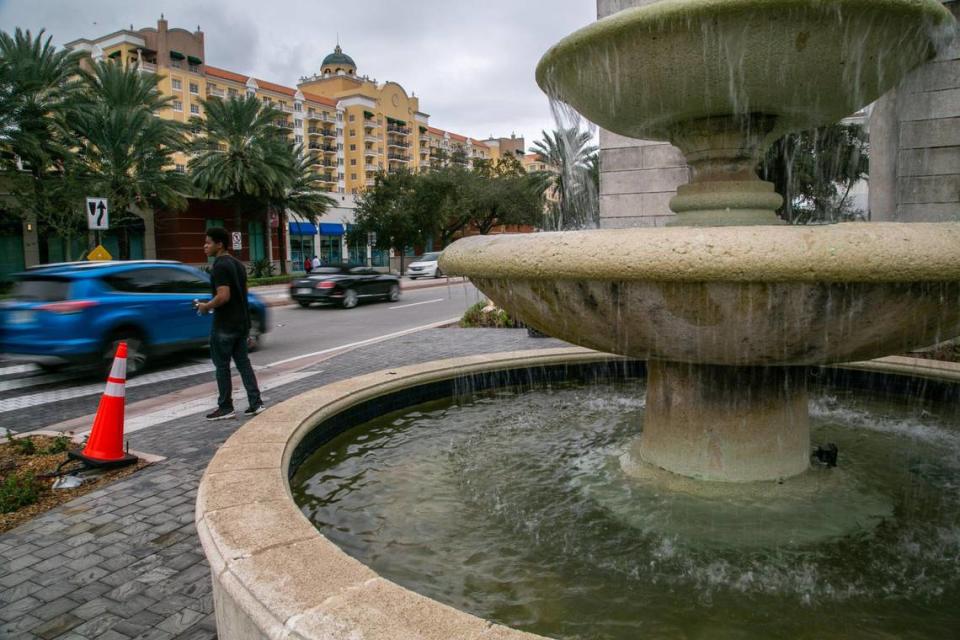‘Miracle Mile is sick.’ Coral Gables looks to redevelopment to save iconic street
Looking to rejuvenate an ailing Miracle Mile, Coral Gables commissioners say they’re ready to embrace a zoning tweak that could carry big repercussions for one of South Florida’s most iconic streets: significantly easing rules that require on-site parking in new construction on the strip.
The measure, a small piece of a wide-ranging update of the Gables’ famously strict zoning code, could pave the way for extensive redevelopment of the Mile, the city’s premier shopping street.
The proposed new rule would make it far easier for developers to provide “remote” parking for tenants and customers — that is, make a deal for them to park elsewhere in downtown Coral Gables. Studies show that parking across the business district is both plentiful and severely underused.
Backers say that simple expedient would unlock the potential for new retail, office and even residential development along the Mile by essentially lifting requirements for on-site parking within the envelope of new construction. Those requirements, they say, now make redevelopment along the Mile and its narrow, shallow lots physically and economically unfeasible.

The parking proposal appears to enjoy broad support among elected officials, city administrators and business leaders, who say the Mile is in desperate need of modernization. They contend the street has been hobbled by property owners’ inability to replace or expand the one-story storefronts — in many cases tiny and obsolete — that were built after World War II and still dominate the Mile.
Despite a recent $25 million streetscape makeover that widened sidewalks and beautified the street, the Mile is plagued by vacant storefronts, a longstanding issue that has only been worsened by prolonged street reconstruction and the COVID-19 pandemic. A recent count by the Miami Herald found 37 empty shopfronts along the half-mile-long street.
“Miracle Mile is sick,” Coral Gables Mayor Raul Valdes-Fauli said at a recent commission debate over the new zoning rules. “Miracle Mile is in deep trouble. And unless we do something to stimulate it, it is going to go down.”
But exactly how much new development should be encouraged on the Mile as parking requirements are eased, and at what scale has become a sharp bone of contention among commissioners as the City Beautiful undergoes a sustained wave of new construction in and around its increasingly dense downtown.
Though all five Coral Gables commissioners say they support the remote-parking measure, a debate between two mayoral contenders, commissioners Vince Lago and Patricia Keon, over related limits to new development on the street became so heated that board members unanimously agreed to break out the Miracle Mile plan from the broader, largely uncontroversial zoning rewrite. With Valdes-Fauli opting for political retirement, Lago and Keon are seeking the mayor’s seat in elections next year.
Expanded remote parking would offer property owners and developers on the Mile far greater flexibility to build up to a height of 70 feet, or about six stories — the current cap, established by a previous zoning rule that would remain in place. Keon says she’s satisfied that the height cap and requirements for buildings to “step back” at 45 feet will be sufficient to preserve the street’s pedestrian-first feel and intimate scale.
But Lago wants to restrict the size of new buildings further, saying he fears the result otherwise could be a “monolithic” new six-story scale along the entire Mile, a prospect other critics have likened to a concrete canyon. He argues developers should be willing to accept further limits on size in exchange for the right to forgo building costly parking decks.
The commissioners will hash out the remote parking measure and some possible tightening of restrictions on new Miracle Mile development at a special virtual workshop Nov. 30, before a final vote on the full zoning rewrite that’s scheduled for Dec. 8.
Developers with holdings on Miracle Mile, including the street’s largest property owner, Terranova Corp., have been quietly watching the debate. The group’s plan for a boutique hotel on the prominent corner of Miracle Mile and Ponce de Leon Boulevard stalled in 2019 amid issues with provision of off-site parking and some public and political blowback over its proposed seven-story height.

Terranova Chairman Stephen Bittel said he supports the remote-parking measure, developed as part of the broader zoning update by city planners and its consultants, the Miami firm of Duany Plater-Zyberk.
“Miracle Mile, as a result of COVID-19 and changed retail patterns, is at a low point of the last 20 years,” Bittel said in a brief interview. “City staff and their consultant Elizabeth Plater-Zyberk, a renowned urbanism expert, have come up with an enlightened plan for the future.”
“The definition of insanity is to do the same thing again and again and expect different results,” Bittel added, alluding to critics who oppose changes on the street.
To bring desperately needed attention to the Mile and generate some activity, Bittel and the city teamed up in October to temporarily turn over a half-dozen vacant storefronts for use as shared working studios and galleries for artists. The artists will remain at least through the end of the year, depending on when shops are leased.
The studios are open to the public. Artists say the experience of working with and meeting other artists has been good. But business has been light, though some curious pedestrians do drop in.
“It’s been slow, but people are happy that this is going on,” said ceramicist Laura Mármol.
The debate over the Mile’s future could be consequential beyond Coral Gables’ borders. The city’s busy downtown is a major regional office hub but has found itself increasingly in a losing competition, at least pre-COVID-19, for retail and dining customers with newly vital entertainment districts in Wynwood and nearby Coconut Grove, among others.
And how the city, famed for its careful planning, handles the parking question could provide new impetus to efforts by some planners and activists in the Gables and elsewhere in Miami-Dade County. Some have called for easing of what they describe as onerous on-site parking requirements that block needed new development on small lots and foster over-scaled construction and lot aggregations, inflating housing and other costs.

Miracle Mile property owners holding at least 200 feet of frontage can already apply for remote parking. But most have single lots of small holdings and don’t qualify, one reason nothing new has been built on the street in 15 years. New construction under current rules would require aggregating lots and building big with parking decks and ramps — something the city wants to discourage.
The new rule would make remote parking available to those small property owners, who could then build to three or four stories, Plater-Zyberk said. The hope is those upstairs floors, where retail won’t work, will be offices or apartments, boosting foot traffic to help sustain the shops and restaurants at street level, she said.
The measure would encourage development of a modest, pedestrian- and neighborhood-friendly scale that’s economically sustainable and largely missing in the city, she added.
“It will be kind of an urban street that’s developed incrementally. Hopefully it would be an interesting, varied streetscape, rather than one long building,” Plater-Zyberk said. “The city has lots of big, tall buildings, and some little, small buildings, and nothing in between. We’re hoping to bring in that missing middle.”
Anthony De Yurre, a partner at Bilzin Sumberg who represents some Coral Gables developers, said some limits could work if carefully calibrated, but he said the remote-parking measure is essential if Miracle Mile is to thrive.
“It depends on what you think the vision of Miracle Mile should be,” said De Yurre, who has no clients with property or a project on the Mile, but represents developers bidding on a stalled city project to redevelop obsolete public parking garages next to it.

“It comes down to a pedestrian scale. That to me is what the debate is about. They’re really going to get granular with it on Monday. They know it’s going to have a tremendous impact on the Mile. I think you will see a new Miracle Mile in the next 10 years.”
At the November workshop, commissioners will also consider a second zoning change that would expand the city’s downtown.
The broad zoning update doesn’t affect single-family or residential-only neighborhoods, but this proposal would be an exception. It would rezone an anomalous, two-and-a-half block island of single-family homes and duplexes that’s surrounded by larger-scale residential and commercial development.
That change comes at the request of a majority of property owners in the section, who signed a petition asking for it to be upzoned for commercial or mixed use so they can sell out. Originally part of a plan by city founder George Merrick for a crafts section that was never realized, the small neighborhood is today plagued by cut-through traffic and increasing density around it, including the massive Plaza Coral Gables under construction two blocks to the east.
The city plan is to classify the area under a new category under the zoning rewrite that’s designed to foster more of the “missing-middle” development Plater-Zyberk describes — in this case, low-scale development mixing residential, retail and office uses.

But Commissioner Michael Mena called for a recalibration of the proposed upzoning, citing concerns over the impact on the abutting, historic San Sebastian Apartments, rising four stories at their highest point. Mena doesn’t want any new development to overwhelm the building or residential areas across LeJeune Road.
“This is unique because it’s a three-block area in our downtown. I view it as a blank canvas,” Mena said. “So rather than just come out and upzone and see what comes along, I want to be a little more thoughtful.”
City commissioners have few quibbles with the larger zoning rewrite. Plater-Zyberk and Gables Planning Director Ramon Trias said it mostly streamlines and reorganizes the code, making it easier to navigate and understand.
It also introduces defined zoning categories that mix commercial and residential uses to the code for the first time. Although numerous large mixed-use projects have been built, approval for each one has until now involved a laborious process of negotiation. Adding a set of tailored rules should result in a simpler review process and better buildings, Plater-Zyberk said.
But Miracle Mile has been a sticking point. Lago and Keon both agree on the need for remote parking and more residential development downtown.. But they differ, at times acerbically, on the particulars.

Keon suggests Lago’s concerns are overblown. Most property owners with small holdings would be unable to build to the maximum of 70 feet, or about six stories, she noted.
“You would have to have a certain footprint to do that. Not everything will go to that height. You could have some buildings at three or four stories. You would still have a varied roofline,” Keon said in an interview. “I think what’s important is the scale and the viability of the Mile. You can leave it at two stories, and if all the stores are empty, that’s not a pretty picture.”
But Lago wants to further restrict development capacity to ensure that not every property is built out to the maximum 70 feet. That could be done by barring from the Mile measures that provide additional building capacity to downtown Gables developers — a “bonus” for hewing to Mediterranean style, and the purchase of unused “air rights” from designated historic properties.
“You need to ensure that out-of-scale projects are not built on Miracle Mile, that you’re not allowing developers to build every square foot of the envelope,“ Lago said in an interview. “The idea that additional height will solve the problems of Miracle Mile is wrong. Let’s protect one street, and that’s Miracle Mile.”

 Yahoo Movies
Yahoo Movies 
